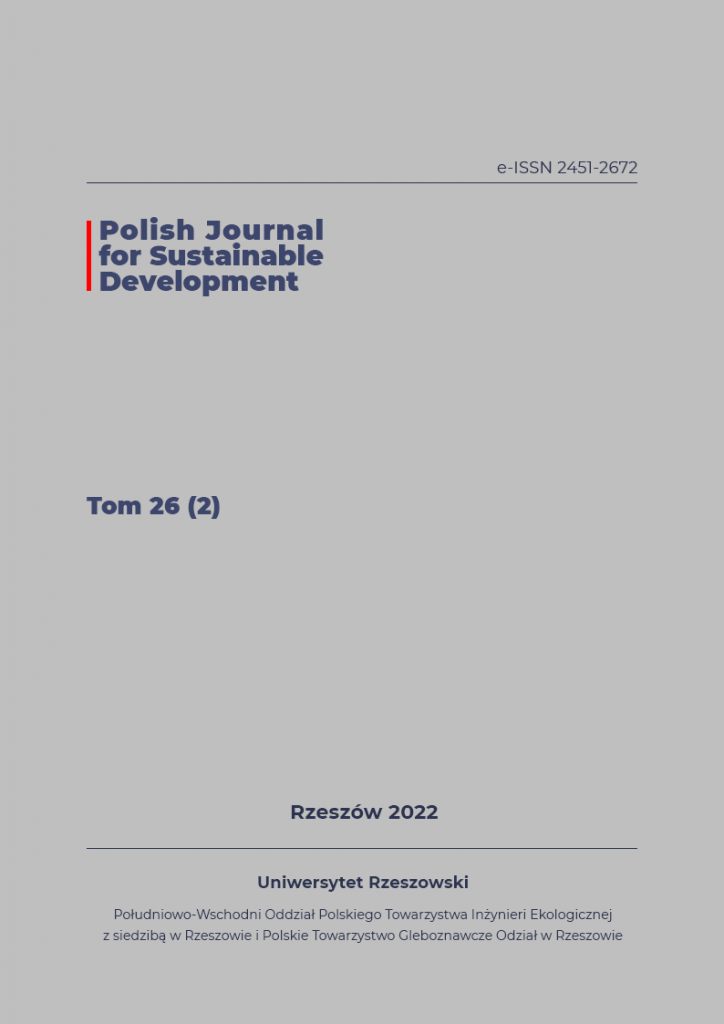Oat grain (Avena Sativa L) and its possible use as an alternative source of energy
DOI:
https://doi.org/10.15584/pjsd.2022.26.2.8Keywords:
oats, cultivars, biomass, energyAbstract
The use of renewable energy sources brings great benefits. Interest in biomass is growing -, because conventional energy significantly burdens the natural environment, and resources of fossil fuels are rapidly decreasing. Surplus cereal grains or grains that do not meet quality requirements can be used for energy production. For this reason, the aim of the work was to conduct research and evaluate the use of hulled and naked oat grains for energy purposes. The calorific value of grain and its ash content were analyzed. On the basis of the conducted research, it was shown that bare forms of oat, compared to hulled forms, are characterized by more favorable calorific properties. They have more fat and fewer ashes in the grain. Among the analyzed cultivars, Polar and Bingo (naked forms of oats) and Krezus (hulled forms) are suitable for energy purposes.
Downloads
References
Bajcar M., Czernicka M., Saletnik B., Zaguła B., Puchalski Cz., Gorzelany J. 2015. Assessment of Energy Properties of Plant Biomass Pellets. TEKA. Commission Of Motorization And Energetics In Agriculture.
Biel W., Bobko K., Maciorowski R. 2009. Chemical composition and nutritive value of husked and naked oats grain. J. Cereal Sci. 49. 413-418.
Biel W., Jacyno E., Kawęcka M. 2014. Chemical composition of hulled, dehulled and naked oat grains. South African Journal of Animal Science. 44 (2). 189-197.
Burczyk H. 2011. Przydatność zbóż na potrzeby produkcji energii odnawialnej w świetle wyników doświadczeń. Problemy Inżynierii Rolniczej. 3/2011. 43-51.
Grzybek A. Kierunki zagospodarowania biomasy na cele energetyczne. Wieś Jutra. 9 (962). 16-21.
Janowicz L. Ciepło z ziarna. 2006. Aeroenergetyka. 1(15). 39-41.
Kaszkowiak E., Kaszkowiak J. 2010. Energetyczne wykorzystanie ziarna owsa i jęczmienia jarego. Inżynieria i aparatura chemiczna. 5/2010. 57-58.
Klima K., Łabza T. 2010. Plonowanie i efektywność ekonomiczna uprawy owsa w siewie czystym i mieszanym w systemie ekologicznym i konwencjonalnym. Żywność. Nauka. Technologia. Jakość. 3 (70). 141-147.
Kwaśniewski D. 2010. Produkcja i wykorzystanie ziarna owsa jako odnawialnego źródła energii. Problemy Inżynierii Rolniczej. 3. 95-101.
Kwaśniewski D. Produkcja i wykorzystanie ziarna owsa jako odnawialnego źródła energii. Problemy Inżynierii Rolniczej. 3. 95-101.
Nakonieczny P., Kluza P. A., Tatar G., Bródka R. 2014. Rodzaje, charakterystyka, oraz wybrane problemy eksploatacji kotłów i pieców zasilanych różnymi paliwami. Acta Scientarum Polonorum. Technica Agraria. 13(1-2). 27-40.
Noworolnik K., Sułek A. 2014. Agrotechnika owsa na cele paszowe i spożywcze. Studia i Raporty IUNG-PIB. 41(15). 167-180.
Piasecka I., Knozowski P., Ropińska P., Tomporowski A. Ignaszak P. 2017. Badanie i ocena możliwości wykorzystania na cele energetyczne rozdrobnionych ziaren zbóż wiechlinowatych. Acta Sci. Pol. Technica Agraria 16(1-2). 47-57.
Podolska G., Nita Z., Mikos M. 2009. Plonowanie i skład chemiczny ziarna nagoziarnistej formy owsa karłowego (STH 5630) w zależności od gęstości siewu i nawożenia azotem. Fragm. Agron. (XXV). 1 (97). 338-346.
Roszkowski A. 2003. Perspektywy wykorzystania biomasy jako źródła paliw silnikowych. MOTROL. 5. 143-151.
Stypczyńska Z., Dziamski A. 2005. Struktura systemu korzeniowego i plon owsa w zależności od następczego wpływu deszczowania i nawożenia azotem. Acta Sci. Pol. Agricultura. 4 (2). 73-82.
Tendziagolska E. 2010. Zmiany wybranych właściwości fizycznych gleby w uprawie owsa nagiego w systemie ekologicznym. Problemy Inżynierii Rolniczej. 2. 31-39.
Tobiasz-Salach R., Pyrek-Bajcar E,, Bobrecka-Jamro D. 2016. Assessing the possible use of hulled and naked oat grains as an energy source. ECONTECHMOD. Vol. 5.3. 35-40. ISSN2084-5715.
Downloads
Published
Issue
Section
License
Copyright (c) 2022 Polish Journal for Sustainable Development

This work is licensed under a Creative Commons Attribution-NonCommercial-NoDerivatives 4.0 International License.


